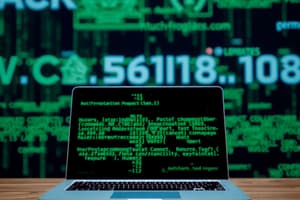Podcast
Questions and Answers
What is the primary goal of the course on Penetration Testing, Ethical Hacking and Network Defense?
What is the primary goal of the course on Penetration Testing, Ethical Hacking and Network Defense?
- To develop new hacking tools for malicious purposes
- To teach students how to conduct ethical hacking and protect systems from attacks (correct)
- To train students to become proficient programmers
- To prepare students for a career in human resource management
Which of the following is a skill students are expected to acquire by the end of the course?
Which of the following is a skill students are expected to acquire by the end of the course?
- Performing reconnaissance on a target network using various techniques (correct)
- Developing business strategies for startups
- Installing operating systems
- Managing human resources in a corporate setting
According to the course objectives, what aspect of ethical hacking is emphasized?
According to the course objectives, what aspect of ethical hacking is emphasized?
- Identifying potential job opportunities in the industry
- Understanding the legal boundaries and limitations of ethical hackers (correct)
- Creating new malware for testing purposes
- Designing web applications for better user engagement
What type of roles and credentials should students evaluate as part of their learning?
What type of roles and credentials should students evaluate as part of their learning?
What type of damage can malicious software cause, as highlighted in the course objectives?
What type of damage can malicious software cause, as highlighted in the course objectives?
Which of the following is NOT a focus area in the Penetration Testing course?
Which of the following is NOT a focus area in the Penetration Testing course?
What scripting languages are students expected to learn for ethical hacking?
What scripting languages are students expected to learn for ethical hacking?
What is emphasized as a method for understanding vulnerabilities in operating systems?
What is emphasized as a method for understanding vulnerabilities in operating systems?
What percentage of the overall evaluation is attributed to the mid-module examination?
What percentage of the overall evaluation is attributed to the mid-module examination?
Which of the following best describes a threat in the context of ethical hacking?
Which of the following best describes a threat in the context of ethical hacking?
What does an exploit refer to in the context of ethical hacking?
What does an exploit refer to in the context of ethical hacking?
What is one of the key responsibilities of an ethical hacker?
What is one of the key responsibilities of an ethical hacker?
What is the primary goal of ethical hacking?
What is the primary goal of ethical hacking?
Which of the following statements best defines a vulnerability?
Which of the following statements best defines a vulnerability?
What do the 'Rules of Engagement' typically describe in a penetration testing scenario?
What do the 'Rules of Engagement' typically describe in a penetration testing scenario?
How do ethical hacking and penetration testing differ?
How do ethical hacking and penetration testing differ?
What is the purpose of the Non-Disclosure Agreement (NDA) in ethical hacking?
What is the purpose of the Non-Disclosure Agreement (NDA) in ethical hacking?
What mindset should penetration testers and ethical hackers maintain?
What mindset should penetration testers and ethical hackers maintain?
What phase follows the testing in the overall penetration testing process?
What phase follows the testing in the overall penetration testing process?
Which of the following components is NOT part of the ethical hacking evaluation methods?
Which of the following components is NOT part of the ethical hacking evaluation methods?
What does the term 'risk' refer to in the context of ethical hacking?
What does the term 'risk' refer to in the context of ethical hacking?
How does ethical hacking differ from traditional hacking?
How does ethical hacking differ from traditional hacking?
In ethical hacking, what does the vulnerability represent?
In ethical hacking, what does the vulnerability represent?
What is encompassed in the preparation phase of penetration testing?
What is encompassed in the preparation phase of penetration testing?
What is the primary purpose of obtaining a Permission Memo before testing?
What is the primary purpose of obtaining a Permission Memo before testing?
Which field in the IPv4 header determines how many hops a packet can make?
Which field in the IPv4 header determines how many hops a packet can make?
Which of the following is NOT part of the required configuration settings for TCP/IP?
Which of the following is NOT part of the required configuration settings for TCP/IP?
What does a subnet mask do in a TCP/IP network?
What does a subnet mask do in a TCP/IP network?
In binary notation, what does the subnet mask 255.255.255.0 represent?
In binary notation, what does the subnet mask 255.255.255.0 represent?
What format is commonly used to express an IP address?
What format is commonly used to express an IP address?
How many bits are in an IP address under IPv4?
How many bits are in an IP address under IPv4?
Which of the following correctly describes an octet in the context of an IP address?
Which of the following correctly describes an octet in the context of an IP address?
Flashcards
Ethical Hacking
Ethical Hacking
Using hacking techniques to find and fix security vulnerabilities in a system, rather than for malicious purposes.
Penetration Testing
Penetration Testing
Simulating cyberattacks to identify weaknesses in a computer network or system.
Vulnerability
Vulnerability
A weakness in a system that can be exploited by an attacker.
Reconnaissance
Reconnaissance
Signup and view all the flashcards
Malicious Software
Malicious Software
Signup and view all the flashcards
Operating System (OS) Vulnerabilities
Operating System (OS) Vulnerabilities
Signup and view all the flashcards
Security Devices
Security Devices
Signup and view all the flashcards
Cryptography & Hashing
Cryptography & Hashing
Signup and view all the flashcards
Threat
Threat
Signup and view all the flashcards
Risk
Risk
Signup and view all the flashcards
Ethical Hacker Mindset
Ethical Hacker Mindset
Signup and view all the flashcards
TCP/IP Protocol Stack
TCP/IP Protocol Stack
Signup and view all the flashcards
IP Addressing
IP Addressing
Signup and view all the flashcards
What is a security exploit?
What is a security exploit?
Signup and view all the flashcards
What is the main goal of ethical hacking?
What is the main goal of ethical hacking?
Signup and view all the flashcards
What is a penetration test?
What is a penetration test?
Signup and view all the flashcards
What is a vulnerability?
What is a vulnerability?
Signup and view all the flashcards
Why is ethical hacking important?
Why is ethical hacking important?
Signup and view all the flashcards
What are the phases of the penetration testing process?
What are the phases of the penetration testing process?
Signup and view all the flashcards
What is an NDA (Non-Disclosure Agreement)?
What is an NDA (Non-Disclosure Agreement)?
Signup and view all the flashcards
What are Rules of Engagement?
What are Rules of Engagement?
Signup and view all the flashcards
TTL Field
TTL Field
Signup and view all the flashcards
Source IP Address
Source IP Address
Signup and view all the flashcards
Destination IP Address
Destination IP Address
Signup and view all the flashcards
Dotted-Decimal Format
Dotted-Decimal Format
Signup and view all the flashcards
Subnet Mask
Subnet Mask
Signup and view all the flashcards
Default Gateway
Default Gateway
Signup and view all the flashcards
Octet
Octet
Signup and view all the flashcards
Study Notes
Profiles
-
Leonardo Brown:
- MBA in Information Systems
- MSc. in Cyber Security
- BSc. in Telecommunications Engineering
- GIAC® Penetration Tester (GPEN)
- Over 30 years of experience in ICT/Digital Transformation
- Email: [email protected]
- Telephone: 876-428-3091
-
Michelle Reid:
- MSc. in Teaching
- BSc. in Human Resource Management
- Certified Management Analyst
- Email: [email protected]
- Telephone: 876-236-0211
Course Information
- Course: BSc. in Cyber Security and Digital Forensics (CSD4115)
- Course Title: Penetration Testing, Ethical Hacking, and Network Defence
- Duration: 45 hours
- Credits: 3
- Semester: 7
Course Purpose/Why
- The course aims to train students to become skilled security testers.
- It teaches hacking strategies and tactics used by ethical hackers ("White Hats").
- It covers methods of vulnerability exploitation.
- It highlights the use of open-source scripting languages and hacking toolkits.
- Understanding hacker tools and methods helps security testers protect systems.
Course Objectives
- Students should be able to define the scope of ethical hacking.
- Students will learn about penetration testing credentials and roles.
- Students will learn reconnaissance techniques on target networks.
- Students will learn about different types of malicious software and their damage potential.
- Students will enumerate and classify vulnerabilities in Microsoft and Linux operating systems.
- Students will learn to control and protect web servers and wireless networks.
- Students will evaluate and choose cryptography and hashing methods.
- Students will learn to implement security devices (routers, firewalls, Intrusion Detection Systems, honeypots).
Methods of Evaluation
- Coursework (50%):
- Individual Presentation (10%)
- Group Presentation (10%)
- Lab/Pop Quiz (5%)
- Mid-module Examination (25%)
- Final Examination (50%)
Unit One: Ethical Hacking Overview
- Describe the role of an ethical hacker.
- Describe legal actions an ethical hacker can take.
- Describe actions an ethical hacker cannot take.
Unit Two: TCP/IP Concepts Review
- Describe the TCP/IP protocol stack.
- Explain the basics of IP addressing.
- Explain binary, octal, and hexadecimal numbering systems.
Ethical Hacking Overview (Mindset)
- Successful penetration testers/ethical hackers need contradictory concepts.
- Think outside the box, use pragmatism, differentiate; be thorough, methodical.
- Balance between these two is crucial for success.
Ethical Hacking Overview (Terms)
- Ethical hacking is the process of using hacking techniques legally to find security flaws.
- To start the session, define terms like ethical hacking, penetration testing and how they differ.
- Ethical hacking is about finding flaws in a system.
- Penetration Testing is the practice of using attack techniques.
Ethical Hacking Overview (Threats, Vulnerabilities, Risk, Exploit)
- Threat: An actor or agent that may/can cause harm. Examples include organized crime, spyware companies, or disgruntled employees.
- Vulnerability: A flaw in the system that attackers exploit.
- Risk: When a threat and vulnerability overlap. This means if there’s a vulnerability, an attacker could exploit it.
- Exploit: The vehicle (tool or method) attackers use to cause harm.
Ethical Hacking Overview (Process)
- The penetration testing process involves preparation, testing, and conclusion phases.
- This often includes a Non-Disclosure Agreement (NDA), especially when testing is conducted by a third-party.
- Rules of Engagement are needed to explain exactly how testing will occur.
- Crucial: obtaining official, written permission before conducting tests, even within an organisation.
Ethical Hacking Overview (Laws)
- Many countries have laws to deal with cybercrimes.
- Penetration testers/ethical hackers should strictly adhere to these laws.
- A "Permission Memo" is a useful document demonstrating that a company grants permission to conduct tests.
TCP/IP Concepts Review (More detail)
- IP Version 4 (IPv4) Header: (contains details about how the packet should be handled) Includes TTL (Time to Live), Protocol;Source IP Address, Destination IP Address, etc.
- Configure TCP/IP requires IP address, subnet mask, default gateway.
- An IP address is a 32-bit number that identifies a device on a network.
- IP addresses are normally written in dotted-decimal format (e.g., 192.168.123.132).
- Subnet mask (e.g., 255.255.255.0) determines local/remote networks.
- A default gateway is a router that links different networks.
- TCP connections use a three-way handshake to confirm communication.
Studying That Suits You
Use AI to generate personalized quizzes and flashcards to suit your learning preferences.




